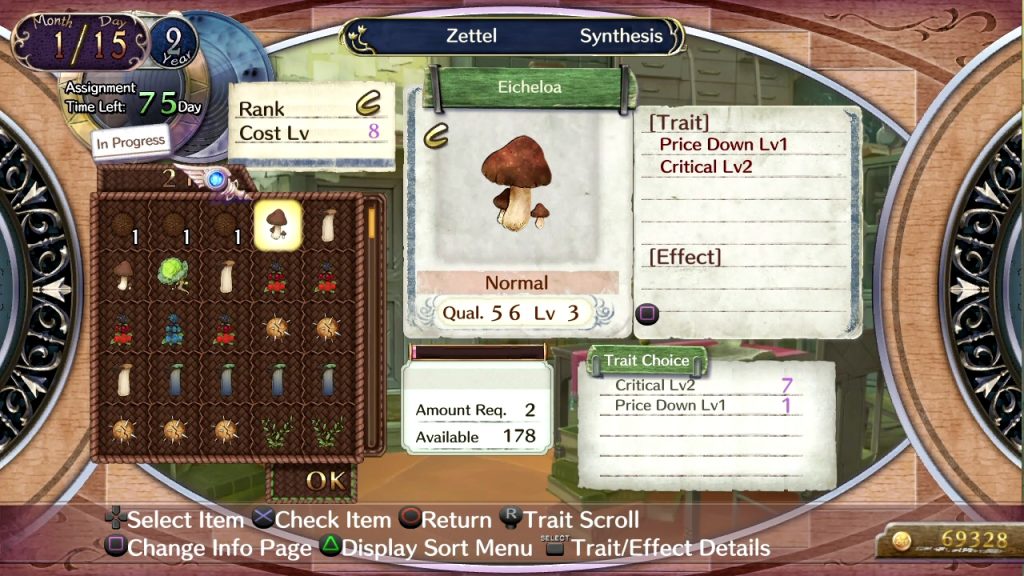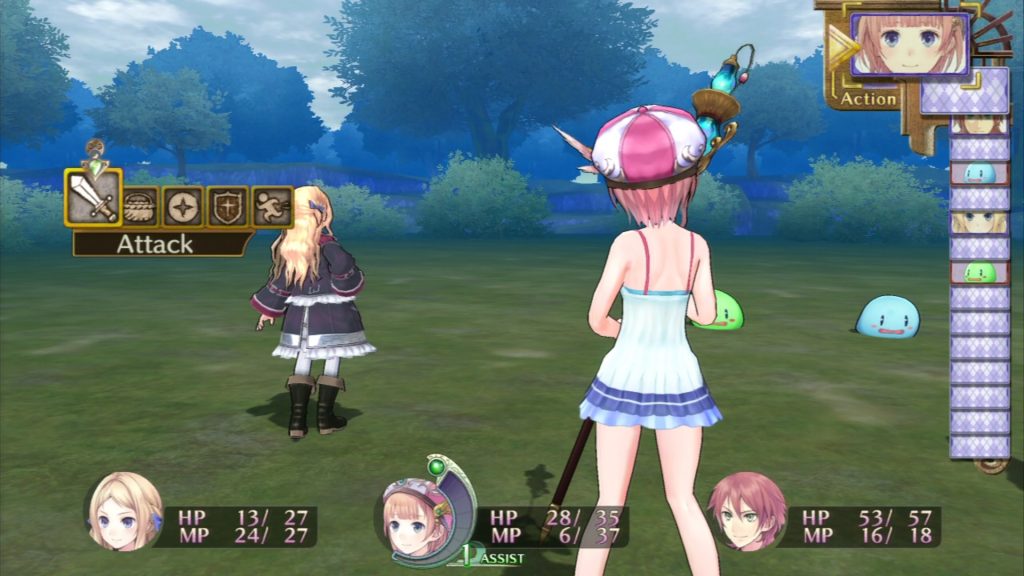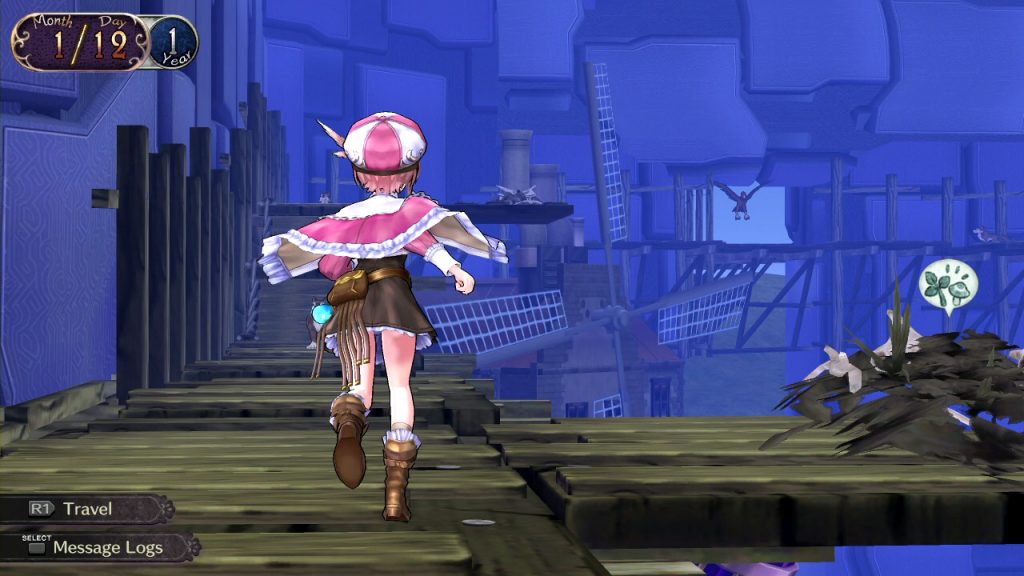Game Name: Atelier Rorona: The Alchemist of Arland Plus (2009 originally, 2014)
Developer: Gust Co. Ltd. (makers of the Ar Tonelico series, Mana Khemia) -http://www.ateliergames.eu/roronaplus/
Platform: PS3, Vita, a 3DS version exists kind of (reviewed on Vita)
Categories: Single Player, Extreme Crafting, Innocent/Endearing, JRPG, Item Hoarding, Time Management, Assignment Driven, Turn Based Combat, Deliberately Slow Pacing
May Appeal To: event planners, efficiency experts, min-maxers, stat crunchers, inventory jugglers, the young at heart, OCD sufferers, and the Japanese
May Repulse: twitch gamers, violence cravers, Ritalin poppers, anime shirkers, crafting haters, and fundamentally anyone missing the attention span to notice incomplete
Comparable To: the ominously looming time restrictions of Dead Rising just with a de-emphasis on rampantly comedic decapitations; the game also rings true with the overall structure and vibe of Rune Factory 4 though with a declared purpose and direction. This has less ‘Mine’ and 30 times more ‘Craft’ than Minecraft, though the turn-based combat is a no-frills, barely competent vision of literally any other JRPG. Way, way more chipper than Fullmetal Alchemist.
Learning Curve: I was still discovering facets of the crafting system halfway through.
Game Length: 20 hours shortplay, maybe 60+ as a reflection of your anal-retentive stat smashing
Difficulty: If minion combat = cake, then the optional boss combat would be akin to chowing down on an Airstream recreational vehicle in the likeness of a Hostess Twinky. The game is indifferent to your proficiency level though.
Mastery: Rewards abound for the dedicated craftswoman: overpowered gear, multiple “endings”, secret scenes, outfits, relationships, and locations to plunder. New Game + allows for carryover from your original journey
Story: At the pinnacle of her career as a lounging couch cushion whom owns an alchemy shop, Astrid Zexis sends Rorolina Frixell to answer the summons of our dapper knight Sterkenburg Cranach whom holds a mandate to forcibly close said alchemy shop.
….Don’t worry about it. In fact, I had no idea the characters had such goofy names until browsing the wiki. (They go by Astrid, Rorona, and Sterk in the game.)
Suffice to say that despite this city’s original appreciation of their benevolent era of industrialization, they renege on the sole promise to a traveling alchemist that unlocked the technological secrets of a dead civilization for the humble bargain of a mere storefront window. Whether or not the property values of being a stone’s throw from the king’s doorstep skyrocketed with the newfound prosperity of Arland, the result is the same:
Sterk tasks Astrid who tasks Rorona -vis-a-vis the player- with proving the shop’s continued worth over the course of three years. (Your character is effectively an indentured servant since her master can apparently prevent Rorona’s parents from dying or even conjure human analogs out of thin air but barely bests the motivational drive of a drunken sea sponge.) With a throng of kindred merchants and adventurers seeking to befriend, assist, [or grope] the titular heroine, thus begins the taxing struggle to strip mine the countryside and bean every wolf/eagle on the head with your walking stick.
Presentation: This is a world of simple folk, simple designs, tons of sprite-fueled menus, bubbling tunes, and bright colors. Although a handful of chimes can get repetitive and resound cheaply, the ‘Plus’ re-release enjoys a definitively better looking experience regarding textures, layout, models, and atmospherics. I found myself joyfully whistling the main theme while clicking icons representing my latest haul, having returned from a carefully-planned trek across the sprawling world just beyond the cusp of Arland city’s gates. (About 10 localized map nodes represent around 5-10 small road or field areas each.) Dialogue is exchanged through your familiar left-right format, much of it voiced, though I’ll still gripe about the industry’s stunning pittance of frames in such things since this game trods the well-established path of having a person’s emotional range truncated to 3 facial variations (one with a red smudge) and a repositioning of the arms. All in all though, it’s a unified front that keeps the mood jovial and the interface engaging enough to peruse long hours in finding that perfect blend of desired alchemy traits. When the game decides to jazz itself up, spell effects are fun to watch and the brief cutscenes help embellish the characterization, though attack and walking animations are pretty stiff across the board. Luckily, this game skates the edge of this style and isn’t over-bearingly cutesy either.
Unique Features: Yo dawg, I heard you like crafting. Rune Factory 4 had a very open-ended nuance to it whereas this game has a purposeful set of goals that allow it to retain more of a rhythm. I’d have originally stated that planning 3 month chunks of gameplay like your grandmother sorting pills into containers marked with giant letters denoting weekdays would have been a detriment; somehow this game makes ‘scheduling’ a pleasant and unique feature. You craft your own armor, weapons, healing items, confections, decorations, and accessories from the base materials you find scattered about the countryside -everything has a purpose, a price, and a time period for its implementation along with ingredient quality levels, inherent traits, inherited traits, and rarity. In short, crafting is glorious and without peer.
Gameplay: Your average span of 3 months will go something like this: Sterk has evaluated your previous assignment on a 1-3 star rating, and briefed you on what his bosses inexorably demand despite them rarely admitting they have no notion of the requested item’s purpose. Let’s say the vaguely villainous Governor Meredith (he’s the closest thing to malignant intent in this game though the man’s demeanor strikes closer to an incompetent old crank hurling insults at kids’ proximity to his lawn) will shut down Rorona’s shop unless she turns in undisclosed amounts of Witch’s Salves, Beast Statues, and Healing Aromas. The grading system is suspect, itself, but within your 90 day period you have free reign to turn in high quality trait-driven items or flood Sterk’s pockets with copious dosages of low quality poisons and salves. You could even focus on a single of the three mentioned items if required – whatever it takes to boost your star evaluation from 0 to 10 (which will later get converted into a 3 star max rating [?!]).
Making it through the chapter is the easy part. It’s the deluge of tricky bonus assignments, local denizen requests, and friend favors that will have you calculating allocated stock reserves and days of dedicated alchemical processing down to the final 24 hour period. In essence: fulfilling public requests net gold and popularity but cost items, gaining popularity allows for higher tier missions but takes effort to maintain, failing/abandoning requests decreases popularity, public bounties award gold but require exploration, friend favors build relationships but cost valuable items, exploring yields items but costs days, crafting costs both days and items, selling acquires gold but loses items, learning new recipes requires money, certain events cost days, and disassembling sacrifices equipment for raw materials and costs gold. Fortunately, you set your own goalpost whether it’s to max out a couple relationships in order to see their designated endings, tackle each of the over-powered boss hunts on the map, or to min-max your honing craft in order to perfect your adventuring equipment for your chosen A team. Or maybe you just want to alchemy your way to the perfect uber bomb -a box of dynamite that could be feasibly instilled to one-shot any enemy into oblivion (not recommended for public rideshares, themselves).

Grocery shopping in real life will take on new flavors, post-Atelier Rorona.
Additional Comments: The Rorona Plus version features essential revisions that add to the experience. The flow of battle, the quests and worlds available, the extent of crafting, and especially the graphics have come a long way. Of note, the new ability to hold 1999 items in storage is essential.
What I Liked: The game has more charm than a box of Irish breakfast cereal. The menus are pretty, crafting is obsessively compelling, and the low bar for chapter passage encouraged me to overachieve in nearly every aspect. The game basically says, “Oh, could you just loosen this jar for me?”, and then I respond, “Jars? Why, I’ll make you a whole pantry of jars filled with exotic sundries, tinctures, and animal parts from across the land!” The fact that all products eventually sold in the cafe, at the blacksmith, at the general store, and through the ghost woman’s parlour all tie back to your efforts as a player makes the world reactionary to your labors and provides a framework that is worthy of investing time. In retrospect, the game options had a masterfully paced learning curve as well. Some of the more interesting elements involve choosing a secondary tier of rewards that are unlockable by placing stamps in a tic-tac-toe grid of benefits and can vary from increased stats to money to new equipment. I liked the monster bounties, the statistics/attribute crunching, the hectic chaos you must tame, the unobtrusive storyline, the non-threatening -though difficult- challenges Rorona can overcome, and the fact I can determine my own path without chastisement.
What I Disliked: I don’t like that multiple bombs of any caliber can’t take out an obstruction and that a big-ass rock needs to be killed with a single hit, regaining it’s “health bar” if you don’t. Item descriptions could be more direct. One of the assignments in my playthrough was literally impossible to complete due to RNG. You have to be of a certain level of friendship with a certain character at a certain map location to even discover that select ingredients exist. Also, Rorona Plus’s new garden element was woefully underused or I’m a blithering idiot on where to get seeds from. The 30 some-odd “endings” advertised are mostly just interchangeable sentences saying, “the status quo endured”, and it is an absolute beast to try to see multiple endings that you unlocked. (A Fallout format where they’re shown in succession would have been superior.)
The ho-hum combat starts off tense since your stats/equipment couldn’t handle spreading raspberry jam on a piece of toast. However, with any level of competence a chapter 3 player will handily dispatch or evade the meandering fodder -except for these hulking optional bosses which are quite jarring. At this point, you recall the overlooked ingots, cloth, and armor upgrades you sneezed at earlier in the tale. The game has an “initiative strike” you can perform prior to combat but even letting monsters bumble into your avatar results in many characters being able to hit first and kill with impunity.
And finally: an NPC named “Esty Dee” is just one of few covertly sexualized innuendos that are wildly out of place in a game subsisting of gleefully bopping wildlife on the head and stirring a massive stewpot for 30 hours. Now, I’m cognizant of the Japanese anime counterculture of contestably borderline pedophilia against 2-dimensional pictures that behave as girls half their retconned age, fan service through the inevitable “beach scene” trope, and the high-pitched female squeals and cooing overlaying everything from mortal danger to enjoying a piece of pie. Still, what scant, little evidence of that dark side represented in this game still seems like an affront. It simply doesn’t follow suit to have all female villagers making veiled passes (“or are they?”, asks the game slyly) at your under-aged character who repeatedly says No. This tongue-in-cheek winkery made me feel a little soiled and I wanted to resume the purely carefree item collecting once more. Hyper Dimension Neptunia Re;Birth was a guilty pleasure of mine and is even built around the very concept; however, it just doesn’t belong in Atelier Rorona.
Glitches Experienced: The Vita’s frame rate ramped down while new areas are first loaded (assumedly absent in the PS3 version) as well as some predictable pop-in occurring 10 seconds after running around. Small naming discrepancies involving items can be momentarily confusing: like Golteisen being called Goltizen in an assignment, as well as a request clamoring for a ‘good, gorgeous’ dress needing to be fulfilled by something advertised as a ‘beautiful’ one. Error C2 128128-1 ruined my day on a festival kicking off the third year. It was a persistent hard crash borking upon a splashscreen when loading the next assignment. Thankfully, this went through on the fifth try (after replaying the same festival tournament worth about 5-10 minutes of time each). I had thought I was going to have to skip the entire event by being a wet blanket hermit, but I didn’t want to lose a valuable sun robe. Regardless, it eventually worked somehow.
Hours I Played: 55 hours give or take a restart after figuring out a game mechanic. For reference, I set out to beat all bosses (except the stupid Iron Giant), craft all available items (missed 3), get the True ending, and complete all Sterk assignments (missed 3).
My Personal Reaction: This is very much a game that ignites a candle and let’s you do what you will with its precious light before the wax runs out. I hold an eternal flame for it and hope the rest of the series is as rewarding. What could easily have been a diabetically-sweet veneered vehicle for spreadsheet stat comparison took on a life of its own and became much, much more. The cuteness is so pervasive that even a perv like me rolled his eyes at unnecessary breast physics and ambiguous innuendo as I wanted to help Rorona stave off the untoward advances of female citizens and just save my alchemy shop God damn it. This game will quite possibly craft a home in your heart.
Noob Tips: Some of the most useful items become available without fanfare. Check into these [and how to deploy them] as soon as possible: windrider, secret bag, ice bomb (med and large), bunny tail, traveler shoes, and healing bell. You will never complete all front desk quests, so just accomplish the ones that you can -in fact, if you simply accept only the ones that can be turned in on the spot you won’t embark on an excursion that overlaps the due date.
Depth and Replayability: High, I’m compelled to boot up an NG+ and tackle the same challenges with newfound finesse. All of Rorona Plus’s endings, locations, compendium entries, and God-like gear are enticing.
Suggested Value: Atelier Rorona Plus is $40 and the trilogy is $80. That’s probably about right though I’m not certain if others will like the game as much as I did. Definitely $30
Subjective Categorical Ranking:
(Platform capabilities are considered for Graphics and Sound)
| poor || bad || average || good || great |
Fun Factor |█████████████████████
Unique Gameplay |████████████████
Controls & UI |████████████████
Story & Lore |█████████████████████
Graphics & Style |████████████████
Sound & Music |█████████████████████
—————————————————————————————

Japan! Terrorizing lolitas with disembodied, pastel, chibi emoji expressions has never seemed more normal.
Where to Buy: Gamestop, most common retail Outlets, and the PS Store


